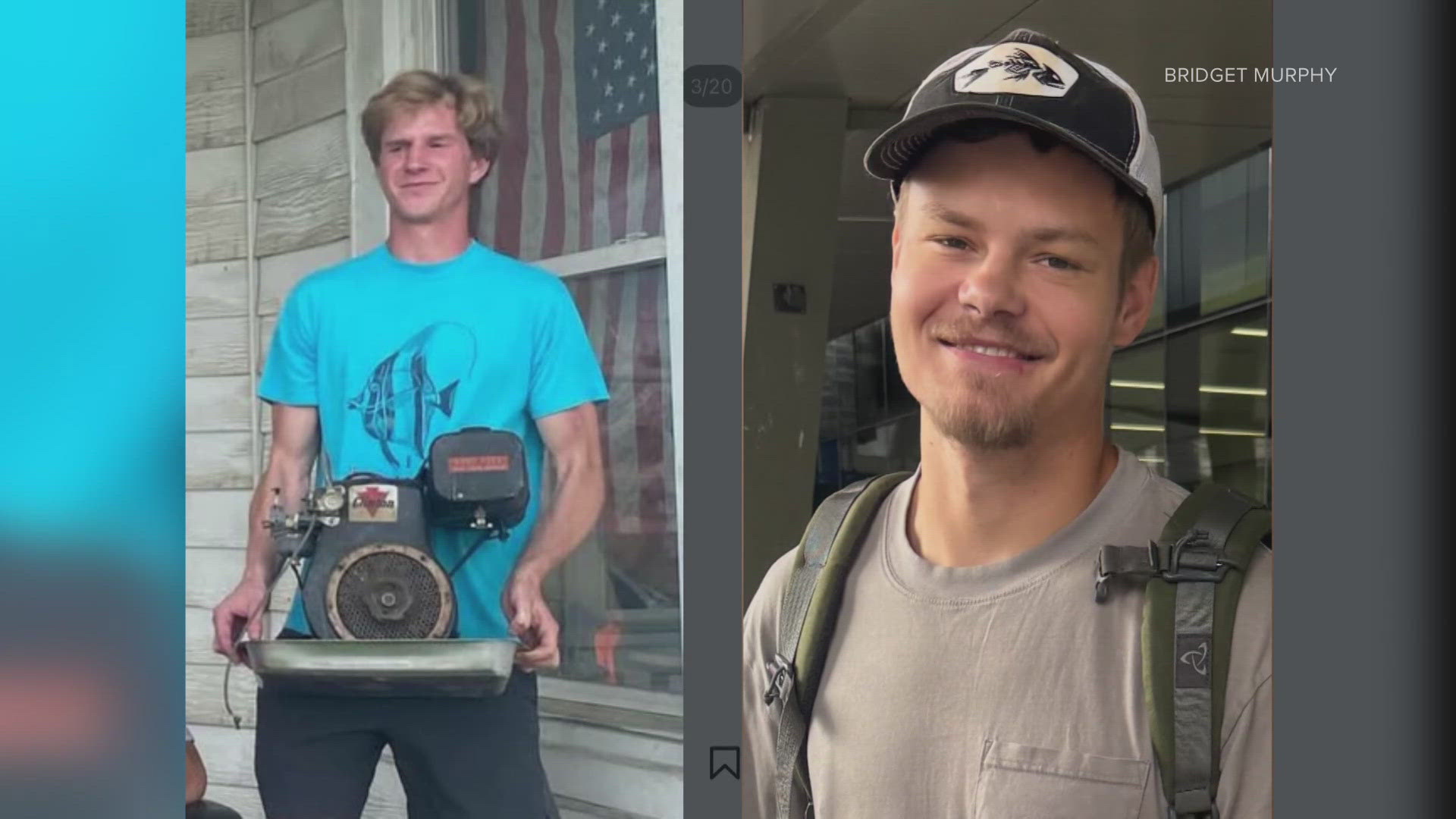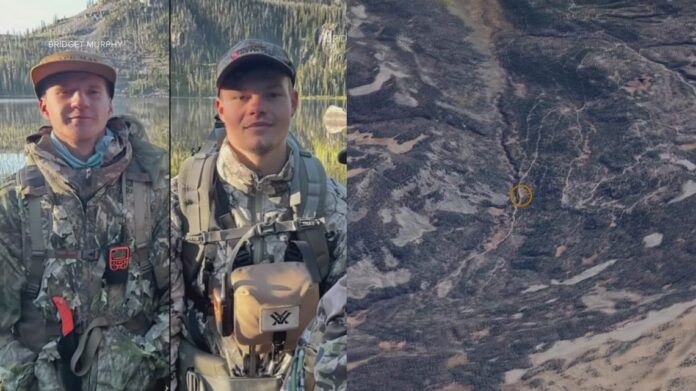EXCLUSIVE: Grieving Fiancée Reveals the 3 Last Words Her Partner Andrew Porter Sent Before Both Hunters Were Found Missing in the Woods of Southern Colorado
In the shadow of the rugged San Juan Mountains, where the air thins and the wild calls to those who dare answer, a tragedy unfolded that has left a community—and a nation—reeling. Andrew Porter, a 25-year-old outdoorsman from Asheville, North Carolina, and his close friend Ian Stasko, also 25, from Salt Lake City, Utah, ventured into the Rio Grande National Forest on September 11, 2025, for what was supposed to be an exhilarating elk hunt. What began as a routine adventure in the vast wilderness near the Colorado-New Mexico border ended in heartbreak, as the two experienced hunters were found dead six days later, victims of a sudden and merciless lightning strike. Their story, pieced together from family accounts, search logs, and official reports, serves as a stark reminder of nature’s unforgiving power.
At the center of this sorrow stands Bridget Murphy, Porter’s fiancée of two years. In an exclusive interview with Grok News, conducted in the quiet confines of her Asheville home just weeks after the devastating discovery, Murphy opened up about the final moments of connection with the man she was set to marry in a few short months. Her voice trembled as she recounted the three words that now echo like a haunting refrain in her shattered world: “I love you.”
It was around 2:45 p.m. on that fateful Thursday, September 11, when Porter’s last message pinged through his satellite communicator—a Garmin inReach device that had kept Murphy and his family tethered to his progress throughout the trip. “The storm’s coming. Heading back. I love you,” the brief transmission read, according to Murphy, who had been receiving hourly updates from her partner since he and Stasko had parked at the Rio de Los Pinos Trailhead earlier that morning. The words, simple yet profound, were a deviation from his usual check-ins, which had been matter-of-fact: coordinates, weather notes, and glimpses of the elk herds they’d spotted. “Andrew was always so practical,” Murphy said, her eyes welling with tears as she clutched a faded photo of the couple hiking in the Blue Ridge Mountains. “But that day, he added those three words. It was like he knew… or maybe he just wanted me to hear them one more time.”
Murphy, 24, a graphic designer with a passion for sustainable farming, met Porter three years ago at a local farmers’ market in Asheville. He was the quiet guy selling handmade leather goods, his hands calloused from years of crafting and climbing. She was drawn to his steady presence, the way he could read a trail map as easily as a love letter. “He grounded me,” she recalled. “We were planning our wedding for spring—nothing fancy, just close family, wildflowers, and a bonfire under the stars.” Porter, an avid hunter since his teens, had invited Stasko—a fellow outdoors enthusiast he’d met through mutual hunting circles—for the trip as a pre-wedding celebration. Stasko, a software engineer with a quick laugh and an encyclopedic knowledge of backcountry survival, was like a brother to Porter. The two had bonded over shared hunts in Utah’s Wasatch Range, trading stories of narrow escapes and perfect shots.

The Rio Grande National Forest, sprawling across southern Colorado’s high country, is a hunter’s paradise—and peril. At elevations pushing 10,000 feet, the area west of Trujillo Meadows Reservoir features dense aspen groves, jagged ridges, and unpredictable weather. Elk season draws thousands each fall, but the wilderness claims its toll: hypothermia, falls, and yes, lightning. Colorado sees more lightning deaths than any other state, with 25 fatalities since 2006, often in the backcountry where storms brew without warning. Porter and Stasko, both seasoned, carried essentials: rifles, daypacks, satellite communicators, and layers for the chill. They left their vehicle stocked with heavier gear—tents, sleeping bags, and food—for what they planned as a quick day hunt, intending to return by evening.
But as Murphy later pieced together from the final pings and witness accounts, things unraveled fast. Around noon, Porter messaged that they’d spotted a promising elk herd on a neighboring trail. “They ditched the main packs to move lighter, figuring they’d be back soon,” Murphy explained, echoing details from the Conejos County Sheriff’s Office reports. Other hunters confirmed sighting the pair alive that Friday morning, September 12, laughing and glassing the horizon with binoculars. Then, silence. The satellite device went dark, and the 24-hour check-in passed without word.
Panic set in by Saturday evening. Murphy, coordinating from Asheville with Porter’s mother and aunt Lynne Runkle, alerted authorities. Deputies from the Conejos County Sheriff’s Office arrived at the trailhead to find the men’s Subaru Outback untouched, keys in the ignition, wet clothes draped inside—signs of a hasty departure into worsening weather. “We broke into the car ourselves at first, desperate for clues,” Murphy said. “Their big packs were there, untouched. They must have thought they’d be gone an hour, tops.”
What followed was a “massive” six-day search that mobilized an army of responders: helicopters from the Colorado Army National Guard, drones scanning the canopy, K-9 units from across the state, and volunteers on horseback and foot from as far as New Mexico. The operation, dubbed one of the largest in Conejos County history, covered hundreds of square miles of treacherous terrain. Fog blanketed the peaks, rain turned trails to mud, and temperatures plummeted to freezing. A GoFundMe launched by Runkle raised over $50,000 in days, funding ATVs, thermal imaging, and even a $10,000 reward for information leading to their location. Social media exploded with pleas: “These boys are savvy, fit, and fighters,” Murphy posted on Facebook. “Please, anyone in the area—hikers, hunters, outfitters—help us bring them home.”
Hope flickered midweek when a confirmed sighting placed them on a side trail Friday morning. “That changed everything,” said Sheriff Garth Crowther in a press release. “We expanded the grid, pushed deeper.” But as days dragged into nights, despair crept in. Murphy flew to Colorado, joining family at a makeshift command center near the trailhead. “I walked those trails myself, screaming his name until my voice gave out,” she shared. “Every rustle in the leaves, every shadow—I thought it was him.”

Then, on Thursday, September 18, at approximately 11 a.m., the unthinkable: Colorado Search and Rescue located two bodies about two miles from the trailhead, clothed but with only a single small daypack between them. Runkle confirmed the grim news on the GoFundMe: “Andrew and Ian have both been found deceased… Please keep their families in your thoughts and prayers.” The coroner’s initial exam revealed no obvious trauma or foul play—just slight burns on their bodies and positions suggesting they’d sought shelter under a large tree.
It wasn’t until September 22, after autopsies, that Conejos County Coroner Richard Martin delivered the final, electrifying truth: lightning. “There was a big bolt of electricity that consumed them,” Martin told reporters, describing how the strike likely occurred on September 12 amid a fierce electrical storm that weather maps later confirmed rolled over the area precisely when communications ceased. Porter and Stasko, caught in the open, had probably hunkered under the tree—the worst possible spot during a thunderstorm. “Instant death,” Martin said. “No suffering.”
For Murphy, the revelation brought a measure of solace amid the agony. “He was just trying to get back to the car as storms rolled in,” she wrote in a Facebook post echoed by outdoor outlets. “They didn’t do anything wrong… It could’ve happened anywhere, to anyone.” Friends remembered Porter as “quiet, focused, and creative,” a steady force who taught Murphy to hunt and revel in the wild’s quiet beauty. Stasko, meanwhile, was the spark—always cracking jokes, pushing the group to new heights.
The story rippled beyond families. David Paulides, author of the “Missing 411” series on wilderness disappearances, noted the irony on X (formerly Twitter): “Hundreds of notes about these two… Lightning. Colorado is unforgiving at high elevation.” Outdoor Life and Field & Stream covered the search in real-time, highlighting the men’s preparation—and the one fatal oversight: not fully heeding the forecast. “Check the weather last,” Paulides advised. “Always.”
As Murphy sifts through memories—Porter’s last hunt in North Carolina, their shared dreams of a cabin in the woods—she clings to those three words. “They were his gift to me, even in the end,” she said, voice breaking. “Andrew loved fiercely, lived fully. Ian was his perfect adventure partner. The forest took them, but it couldn’t take that.”
Memorials are planned for October: a service in Asheville for Porter, another in Utah for Stasko. Donations to search-and-rescue funds continue to pour in, a testament to the outpouring of support. In the end, this tale isn’t just of loss; it’s of love’s quiet endurance against nature’s roar. As Murphy put it, “He’ll always be my world. And I’ll carry his words forever.”




